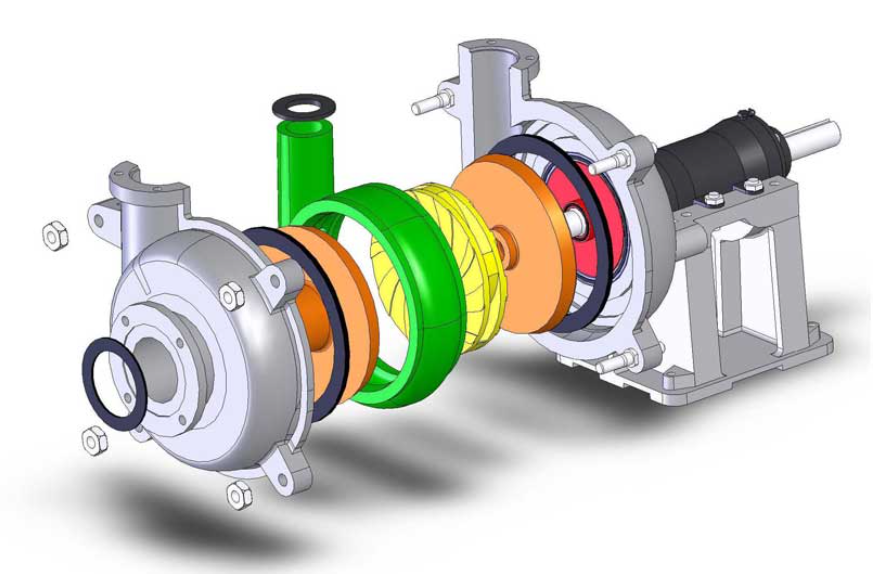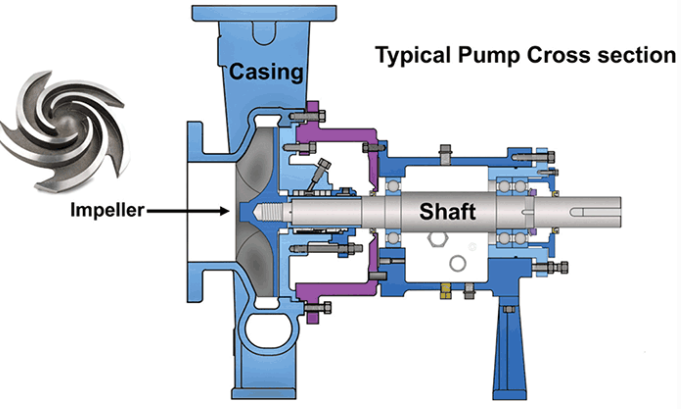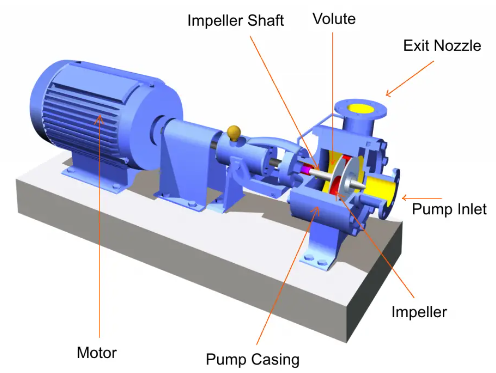

1. What is the primary function of the centrifugal pump shaft?
The centrifugal pump shaft primarily serves to:
Explanation: The centrifugal pump shaft primarily serves to transmit rotational energy from the motor to the impeller, driving the pumping process.
2. Why is structural integrity crucial for the centrifugal pump shaft?
Structural integrity in the centrifugal pump shaft is crucial to:
Explanation: Structural integrity is crucial for the centrifugal pump shaft to withstand rotational forces and vibrations, ensuring smooth and consistent performance.
3. What is the purpose of shaft sleeves in a centrifugal pump?
Shaft sleeves in a centrifugal pump are designed to:
Explanation: Shaft sleeves in a centrifugal pump are designed to protect the shaft from wear and tear, especially when handling abrasive fluids.
4. What factors influence the selection of the centrifugal pump shaft and sleeve?
The selection of the centrifugal pump shaft and sleeve is influenced by:
Explanation: The selection of the centrifugal pump shaft and sleeve is influenced by factors such as operating speed, fluid properties, and pump size.
5. Why are high tensile strength and fatigue resistance important for centrifugal pump shafts?
High tensile strength and fatigue resistance in centrifugal pump shafts are crucial to:
Explanation: High tensile strength and fatigue resistance in centrifugal pump shafts are crucial to withstand rotational forces and cyclic stresses during operation.
6. What is the role of regular maintenance in ensuring optimal performance of the centrifugal pump shaft?
Regular maintenance of the centrifugal pump shaft is crucial for:
Explanation: Regular maintenance of the centrifugal pump shaft includes checking for wear and tear, ensuring proper alignment, and lubricating bearings to ensure optimal performance.
7. What empowers us to make informed choices for specific applications regarding the centrifugal pump shaft?
Understanding the function, design, and material selection of the centrifugal pump shaft empowers us to:
Explanation: Understanding the function, design, and material selection of the centrifugal pump shaft empowers us to make informed choices for specific applications.
Don’t Miss the Relevant Topics on Centrifugal Pumps
| Topics on Centrifugal Pumps | Topics on Centrifugal Pumps |
| Working Principle of Centrifugal Pumps | Centrifugal Pump Mechanical Seals |
| Centrifugal Pump Bearings | Centrifugal Pump Shaft |
| Types of Centrifugal Pumps | Centrifugal Pump Impellers |
| Centrifugal Pump Casing |
Short Article on Centrifugal Pump Shaft

The Centrifugal Pump Shaft: A Backbone of Performance and Reliability
In the heart of every centrifugal pump lies a vital component – the shaft. Often referred to as the backbone of the pump, it plays a critical role in ensuring efficient and reliable operation.
Function and Importance:
- Supports the Rotor: The shaft acts as a rigid framework upon which the impeller, mechanical seal, and bearings are mounted. It transmits the rotational energy from the motor to the impeller, driving the pumping process.
- Provides Structural Integrity: The shaft must be strong and dimensionally stable to withstand the rotational forces and vibrations generated during operation. This ensures smooth and consistent performance.
- Facilitates Sealing: The shaft plays a crucial role in the effectiveness of the mechanical seal, which prevents fluid leakage from the pump.
Design and Material:
Centrifugal pump shafts are typically made of high-strength steel alloys or stainless steel, chosen based on the specific operating conditions and the pumped fluid. These materials offer:
- High tensile strength: To withstand rotational forces and prevent shaft bending.
- Good fatigue resistance: To endure cyclic stresses and vibrations.
- Corrosion resistance: To protect the shaft from the corrosive properties of the pumped fluid.
Shaft Sleeves: An Added Layer of Protection:
To further enhance the durability and performance of the centrifugal pump shaft, shaft sleeves are often employed. These sleeves are hollow tubes made of wear-resistant materials like stainless steel or ceramic. They offer several benefits:
- Extend shaft life: Protect the shaft from wear and tear, especially when handling abrasive fluids.
- Reduce maintenance costs: Minimize the need for frequent shaft replacement.
- Improve performance: Enhance the effectiveness of the mechanical seal.
Choosing the Right Shaft and Sleeve:
Several factors influence the selection of the appropriate shaft and sleeve:
- Pump size and power: Larger pumps require thicker and stronger shafts.
- Operating speed: Higher speeds demand higher-grade shaft materials.
- Fluid properties: Abrasive or corrosive fluids necessitate special materials for both shaft and sleeve.
- Operating environment: Environmental factors like temperature and humidity can affect the material selection.
Ensuring Optimal Performance:
Regular maintenance and inspection of the centrifugal pump shaft are crucial for ensuring optimal performance and longevity. This includes:
- Checking for wear and tear on the shaft and sleeve.
- Ensuring proper alignment of the shaft.
- Lubricating the bearings regularly.
Conclusion:
The centrifugal pump shaft is a vital component responsible for performance, reliability, and long-lasting operation. Understanding its function, design, and material selection empowers us to make informed choices for specific applications. By implementing proper maintenance practices, we can ensure the shaft continues to serve as the backbone of the pump, driving efficient and reliable fluid flow.
Table of Contents
Don’t miss the Course on Effective Isometrics Management: Check Now
Enrollment Link
Recommended courses (Published on EPCLand)
- Complete Course on Piping Engineering
- Basics of Piping Engineering
- Piping Layout Engineering
- Piping Material Engineering
- Piping Stress Analysis
- Material Requisitions
- Piping Material Specifications
- Valve Material Specifications
- Plant Design & Layouts-OISD 118
- Isometric Management
Library of Technical Articles
Don’t miss out the collection of 15+ articles on following topics:
- Basics of Oil and Gas Industry
- Valves
- Testing
- Tank
- Piping Bulk Items
- Pipe
- Metallurgy
- Piping Materials
- Layout
- Instrumentation
- Heat Exchanger
- Type of Contracts
- Codes and Standards
- ASTM Standards
- Articles on Piping Specialty Items
Video details of Complete Course on Piping Engineering
Why Enroll in the EPCLand
Proven Track Record– PTR
Activities & Achievements before launching EPCLand
- Published more than 50+ short courses
- 3000+ Enrolments
- More than 3,500,00 Minutes of watch hours in the last 2 years
- 4000+ Students in 100+ Countries
- Rating of 4+ out of 5
- 1000+ YouTube Videos
- 8K+ Subscribers
What Students will Learn
- Codes & Standards of the Energy Sector
- Piping Material Engineering
- Piping Layout Engineering
- Stress Analysis
Interesting facts
- All the published courses have been developed by Industry Experts with more than 2 decades of experience
- Content is based on Practical experience and real-time problems.
- Content is designed and organized in such a manner that it can be easily grabbed.
- Complete website, Blogs and Quiz sections are Planned, Designed and published by myself (About me: Atul Singla)
- Complete flexibility of Time & Location, Students can access the content from anywhere & anytime
- Moreover, once enrolled, the content can be access as many times as you want, which helps in understand the fundamentals in a better way.
Conclusion
In conclusion, our courses are meticulously crafted by industry experts with over two decades of hands-on experience. The content is rooted in practical knowledge, addressing real-time problems. The material is thoughtfully designed and organized for easy comprehension. Every aspect, from the website to blogs and quizzes, has been planned, designed, and executed by Atul Singla, ensuring a comprehensive and seamless learning experience. With the flexibility of accessing the content at any time and from any location, students have the freedom to learn on their terms. Furthermore, enrollment grants unlimited access, allowing learners to revisit the material as often as needed, fostering a deep understanding of the fundamentals.



